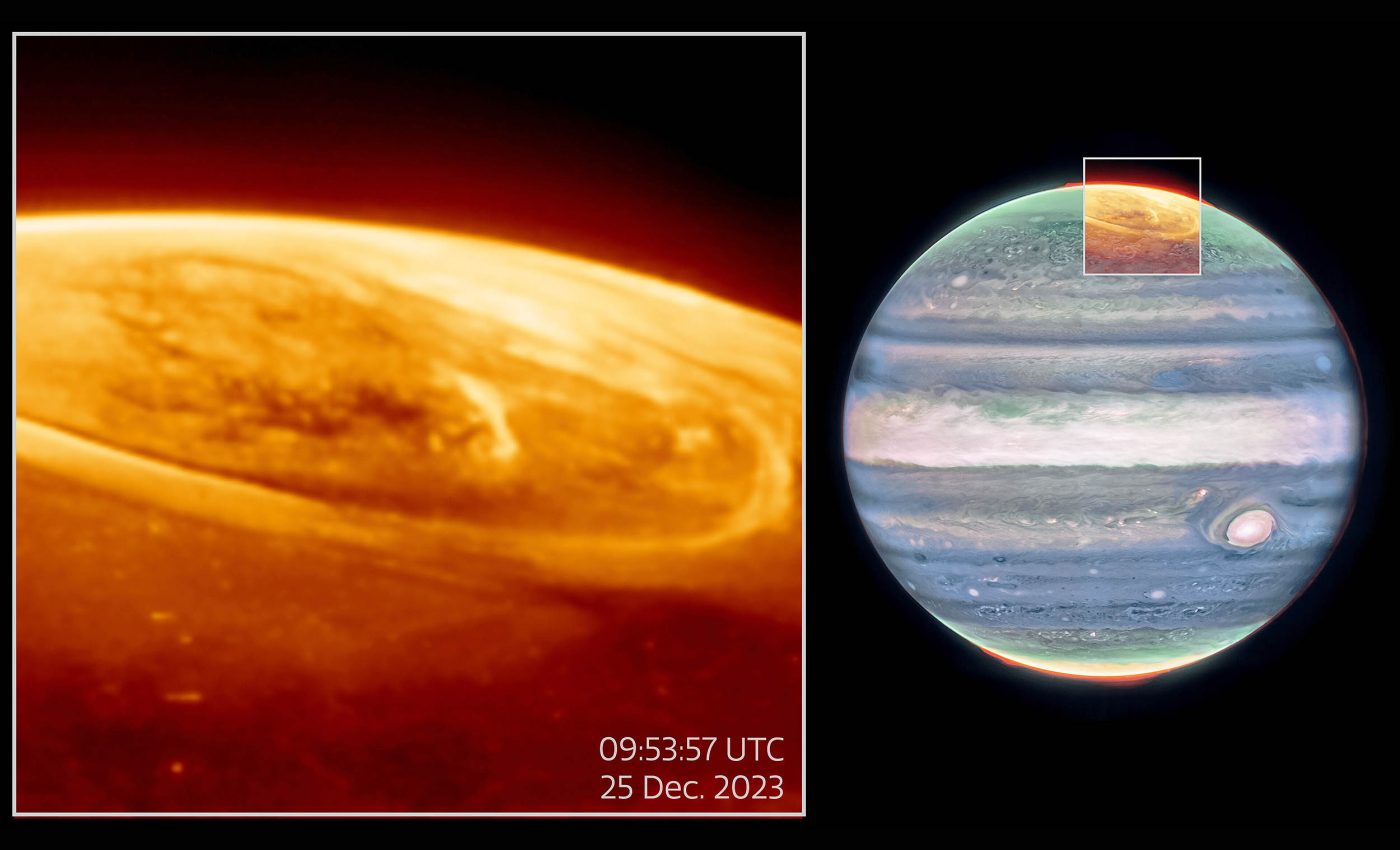
New details from Webb add to the mystery of Jupiter's vibrant auroras
New infrared observations show that the shimmering lights ringing Jupiter’s poles do not glow steadily but flash and flare from moment to moment.
The radiant storms, already hundreds of times brighter than any aurora on Earth, now appear to pulse with unexpected speed, hinting at a dynamic process that governs the giant planet’s magnetosphere.
In a recent study, scientists used the James Webb Space Telescope to record Jupiter’s lights on Christmas Day 2023.
Working with simultaneous images from the NASA/ESA Hubble Space Telescope, a team led by Jonathan Nichols of the University of Leicester discovered that the ionized hydrogen glows known as H3+ vary far more quickly than previous instruments could detect.
Jupiter’s auroras pulse in seconds
Auroras arise when charged particles slam into a planet’s upper atmosphere and excite its gases. On Earth, these particles ride the solar wind.
On Jupiter, they also stream from the volcanic moon Io, whose eruptions fling sulfur and oxygen ions into space.
Captured by Jupiter’s immense magnetic field, the particles accelerate to extreme energies before raining onto the poles.
There, they collide with hydrogen and other gases, producing a spectacle that can outshine the entire infrared sky.
Until now, astronomers assumed these displays waxed and waned over minutes. Webb’s sensitive infrared camera allowed the observers to shorten exposure times and reveal changes on the scale of seconds. The result was startling.
“What a Christmas present it was – it just blew me away,” said Nichols. “We wanted to see how quickly the auroras change, expecting it to fade in and out ponderously, perhaps over a quarter of an hour or so. Instead, we observed the whole auroral region fizzing and popping with light, sometimes varying by the second.”
Webb captures rapid light changes
The new survey relied on Webb’s Near-Infrared Camera, or NIRCam. By taking many rapid snapshots, the instrument traced subtle ripples across the polar haze.
Those ripples correspond to fluctuations in the density of H3+, a three-atom ion that dominates Jupiter’s ionosphere.
Tracking H3+ is crucial because it radiates infrared light that cools the planet’s upper atmosphere. The faster it brightens and dims, the more quickly heat must be cycling through that layer.

Ground-based telescopes had hinted at rapid changes, but Earth’s atmosphere limits their clarity. Webb’s vantage point beyond the atmosphere eliminates those distortions, offering an unfiltered view.
The data show that large sections of the auroral ring can brighten or dim by tens of percent in less than a heartbeat, suggesting bursts of energy sweeping through the magnetosphere.
Ultraviolet mystery emerges
To compare infrared and ultraviolet behavior, the team coordinated with Hubble.
“What made these observations even more special is that we also took pictures simultaneously in the ultraviolet with the NASA/ESA Hubble Space Telescope,” Nichols noted.
Yet the two sets of images did not always match. The brightest light observed by Webb had no real counterpart in Hubble’s pictures.
“This has left us scratching our heads. In order to cause the combination of brightness seen by both Webb and Hubble, we need to have an apparently impossible combination of high quantities of very low energy particles hitting the atmosphere – like a tempest of drizzle! We still don’t understand how this happens,” Nichols enthused.
The mismatch hints that different particle populations may fuel different wavelengths of the aurora. Low-energy electrons might boost infrared emissions without triggering ultraviolet light, or complex chemistry could be masking the signals.
Jupiter’s auroras tied to deep space
The researchers will compare these findings with in-situ measurements from NASA’s Juno probe, which has been orbiting Jupiter since 2016.
Juno records the energies and directions of charged particles that create the lights. Matching those streams to the flickers seen by Webb could reveal how disturbances travel along magnetic field lines from deep space to the cloud tops.
Future help will come from the European Space Agency’s Jupiter Icy Moons Explorer, or Juice, now on its way to the outer Solar System.

Juice will carry seven instruments capable of watching Jupiter’s auroras up close while studying the big planet’s ocean-bearing moons.
By the time Juice arrives in the early 2030s, astronomers hope to have a firmer grasp on how Io’s volcanic blasts, the solar wind and Jupiter’s spinning magnetosphere combine to power the dazzling show.
New view on planetary weather
The discovery that Jupiter’s auroras can flicker, almost as quickly as lightning, reframes theories about how giant planets shed energy.
It also underscores Webb’s strength in time-domain astronomy, where rapid sampling brings hidden rhythms to light.
The observing campaign was logged under Webb program #4566 and Hubble program #17471, but it marks only the beginning. More sessions are planned, aiming to explain the “tempest of drizzle” that defies current models.
For now, the giant’s poles continue to dance to a beat too subtle for earlier telescopes. Thanks to Webb, that beat is no longer a secret.
The study is published in the journal Nature Communications.
—–
Like what you read? Subscribe to our newsletter for engaging articles, exclusive content, and the latest updates.
Check us out on EarthSnap, a free app brought to you by Eric Ralls and Earth.com.
—–













